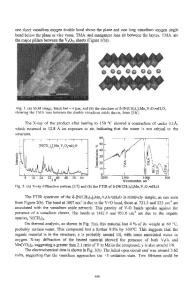Manganese oxides: promising electrode materials for Li-ion batteries and supercapacitors
- PDF / 4,360,125 Bytes
- 19 Pages / 595.276 x 790.866 pts Page_size
- 82 Downloads / 416 Views
REVIEW
Manganese oxides: promising electrode materials for Li‑ion batteries and supercapacitors A. U. Ubale1 · M. A. Waghmare1 · K. S. Iqbal1 · H. M. Pathan2 Received: 24 April 2020 / Accepted: 17 July 2020 © Springer Science+Business Media, LLC, part of Springer Nature 2020
Abstract Nanostructured transition metal oxides (NTMOs) have engrossed substantial research curiosity because of their broad diversity of applications in catalysis, solar cells, biosensors, energy storage devices, etc. Among the various NTMOs, manganese oxides and their composites were highlighted for the applications in Li-ion batteries and supercapacitors as electrode materials owing to their environmental friendly nature and various oxidation states. This review concerns the deposition, characterization, and applications of nanostructured manganese oxide thin films (NMOTFs) during the few decades. The deposition and characterization of NMOTFs are discussed. Characterization discussed here enlightens the structural and morphological studies. The focus of the application section includes Li-ion batteries and supercapacitors.
1 Introduction The origin of numerous scientific and industrial innovations of the twenty-first century is Nanotechnology. It has led to advancements in novel materials on nano-meter scale. A unique aspect of nanotechnology is the significantly increased surface-to-volume ratio of nanomaterials which opens new possibilities in surface-based science. Several physical phenomena become noticeably pronounced as the particle size decreases which comprise quantum as well as statistical mechanical effects. On the nanoscale, materials show different properties as compared to bulk form and enable inimitable applications. Most of the enthrallment with nanotechnology is on the nanoscale. A small particle with any one of the dimensions in the range 1–100 nm is considered as nanoparticle which may include nanocrystals, nanoclusters and nanopowders. Nanomaterials have become promising candidates for numerous potential applications owing to mesmerizing catalytic, magnetic and electrical properties [1–3]. Nanomaterials exhibit outstanding properties as electrode materials such as larger surface areas, * A. U. Ubale [email protected] 1
Nanostructured Thin Film Materials Laboratory, Department of Physics, Govt. Vidarbha Institute of Science and Humanities, Amravati 444604, India
Advanced Physics Laboratory, Department of Physics, Savitribai Phule Pune University, Pune 411007, India
2
lower current densities, higher capacities and excellent electrochemical activities as compared to the bulk materials that make them dynamic electrode materials in the field of electrochemistry. Nowadays, nanostructured transition metal oxides (NTMOs) are the practicable materials for scientists. The applications of NTMOs are increasing day by day. The most commonly used NTMOs are titania, zinc oxide, copper oxide, iron oxide, cobalt oxide, nickel oxide and manganese oxide [4–10]. Out of the rigorously studied nanostructured transition metal oxid
Data Loading...











